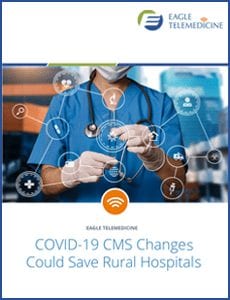Even before the Centers for Medicare & Medicaid Services (CMS) waived site requirements for telemedicine reimbursement in response to the pandemic, rural hospitals benefited from telehealth-friendly legislation to maintain access to care despite the nationwide doctor shortage.
Prior to the waivers related to COVID-19, CMS rules around telemedicine reimbursement didn’t apply to vulnerable urban hospitals. Access to specialists was often constrained even in major cities because of the limited number of doctors in specialties like infectious disease, pulmonology and cardiology. Many urban hospitals struggle to survive and treat underserved communities much like their rural counterparts because of the doctor shortage. In addition, Medicare limited reimbursement for telemedicine services to sites in rural areas—those counties outside of a Metropolitan Statistical Area (MSA) and within a Health Professional Shortage Area (HPSA), as designated by the Health Resources and Services Administration (HRSA).
Now that CMS has lifted site restrictions, as well as waived other requirements that improve telehealth access through agreements with off-site hospitals, urban hospitals are reaping the benefits of inpatient telemedicine. These include access to specialists for treating COVID-19 patients, such as Tele-ICU, TelePulmonology and Tele-ID (infectious disease) physicians, as well as other specialists to treat patients with population-specific issues like drug addiction and diabetes. Now that these doors are opened, it’s time to recognize how inpatient telemedicine can sustain inner-city hospitals and support their communities in a post-pandemic world.
DEA and Telemedicine: Slow Progress Demands Permanent Process
 The relaxation of DEA requirements comes when rural and community hospitals are not only grappling with COVID-19, but also the ongoing national physician shortage and a lack of access to many medical specialists. Telehealth physicians could make great strides in addressing these coverage gaps for the future, but it’s important to remember the regulations are only waived for the duration of the PHE.
The relaxation of DEA requirements comes when rural and community hospitals are not only grappling with COVID-19, but also the ongoing national physician shortage and a lack of access to many medical specialists. Telehealth physicians could make great strides in addressing these coverage gaps for the future, but it’s important to remember the regulations are only waived for the duration of the PHE.
Vulnerable Inner-City Hospitals Lag Rural Ones in Telehealth Options
While the impacts of the geographical maldistribution of physicians on rural communities has been recognized for some time, the shortage of physicians and access to care has often been overlooked in some urban populations. However, as one study recognized, urban underserved communities do actually experience similar doctor shortages in primary care as rural ones, for example. As a report from the American Medical Student Association (AMSA) describes, decades of focusing assistance on underserved rural areas have limited the attention given to cities with health crises.
Urban underserved communities have suffered a similar plight with regard to reimbursement of telehealth services. However, the inequity of restricting telemedicine reimbursement and services at some urban hospitals did not go unrecognized prior to relaxation of CMS reimbursement restrictions. For example, a 2016 American Hospital Association (AHA) report from its Task Force on Ensuring Access in Vulnerable Communities outlined the unique needs of rural and inner-city urban hospitals, defining “vulnerable” as due to “individual circumstances, much more likely to be in poor health and have disabling conditions.” Telehealth was noted as one of the nine most promising “emerging strategies” to ensure healthcare access in these communities.
The report also noted that while there are unique characteristics and parameters that define vulnerable rural and urban communities, many are characteristics of vulnerable communities in general. Of those, one or more may be “necessary and sufficient” to identify such a community.
CMS Changes Could Save Rural Hospitals
 Telemedicine has been a silver lining during the coronavirus response. CMS telehealth rules changed dramatically compared to policies that governed these services in the past.
Telemedicine has been a silver lining during the coronavirus response. CMS telehealth rules changed dramatically compared to policies that governed these services in the past.
This crisis has presented a huge opportunity to help rural hospitals during this crisis, and perhaps in the future.
Another recognition for the need to extend telehealth to underserved communities came from the Medical Group Management Association (MGMA). In a 2019 letter to the Congressional Telehealth Caucus, MGMA noted that some facilities qualified as an HPSA, but didn’t meet the rural geographic requirements. It strongly suggested amending the Social Security Act to permit an originating site of care to be either a rural or urban HPSA to improve outcomes for vulnerable populations.
But forward progress for telehealth legislation that impacts urban communities hasn’t always been speedy. While the Furthering Access to Stroke Telemedicine (FAST) Act that would amend the Social Security Act to allow Medicare coverage of telestroke services no matter the patient’s location was signed in 2018, the Act was first introduced in 2015 and was not actually set to take effect until 2021.
Telemedicine Tackles Inner-City Hospital Challenges
According to the AHA report, the more than 2,000 U.S. urban community hospitals often serve as the “anchor” for healthcare in their community, as well as a significant source of employment. Like rural hospitals, they provide prevention and wellness care in addition to emergency care, as recruiting and retaining primary care physicians is difficult.
For urban hospitals, a robust inpatient telehealth strategy can address many of the challenging characteristics identified in the report, as these examples show.
- Lack of access to primary care: Without primary care, urban populations, like rural, don’t have consistent care, leading to poor health outcomes and trips to the ER that can overwhelm a struggling hospital. Telehospitalists can support a resource-strapped ER by helping admit and treat patients.
- Environmental challenges: Urban air quality is often lower, contributing to high rates of chronic illness like asthma. Unstable and unhealthy housing leads to physical and mental illness and drug addiction, as does witnessing violence or trauma. The ramifications of these situations often require the care of specialists, like telepsychiatrists, who can address the issues after a person is admitted.
- Higher disease burden: Inner-city hospitals deal with a socioeconomically challenged population. CDC data shows that such populations have a higher disease burden from conditions like diabetes, hypertension, kidney disease, emphysema and cardiovascular disease that lead to poor health outcomes. Inpatient telemedicine can address these and improve community health with broad access to specialists and physicians that supplement hospital staff.
Hospital finances are also a challenge for urban hospitals that can’t be overlooked. While rural hospitals may struggle more with remote location, limited workforce and constrained resources, inner-city facilities can struggle to stay financially afloat while pursuing their charitable mission, according to the AHA report. Telehealth offers a way to cost-effectively improve outcomes. For example, having an onsite doctor overnight can run $150 to $175 an hour or more, while a telemedicine doctor is in the $50 to $75 an hour range. This is because cost is spread out across several hospitals, who pay either a flat rate for access to the service or a per-consult fee.
A Solution to Address Healthcare Inequality
Though expanded CMS reimbursement has extended telehealth services to inner-city communities and beyond for now, these changes should extend past the pandemic for more equitable health outcomes in all populations. Efforts by the MGMA, AHA and other stakeholders to improve patient care through telehealth in underserved communities, whether rural or urban, will hopefully continue once the pandemic is over. Expansion of the HPSA guidelines to provide inpatient telemedicine support for vulnerable inner-city facilities is yet another way to address healthcare inequality in America.






